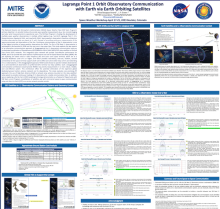Lagrange Point 1 Orbit Observatory Communication with Earth via Earth Orbiting Satellites
Shiva
Basappa Anand
MITRE Corporation
Poster
The National Oceanic and Atmospheric Administration (NOAA) Space Weather Next (SW Next) Program’s primary objective is to provide timely and accurate space weather measurements (e.g., Sun coronal imaging and solar wind measurements) to operational users. The SW Next Program is funding the development of multiple space weather observatories in multiple orbital regimes (e.g., Sun-Earth Lagrange Point 1 (L1), Geosynchronous Equatorial Orbit, and Low-Earth Orbit). Space weather observation’s baseline architecture includes observatories that are placed at L1 with the goal of providing continuous measurements of the space environment and observations of the Sun. Continuous communication of the L1 observatories is one of the highest priorities of space weather observations for NOAA. The first of SW Next L1 observatories is anticipated to be launched in 2028 and the next one in two years later. This study explores the key aspects of an alternative communication approach of disaggregating the L1 observatory communication using an orchestrated combination of Geostationary (GEO)/Medium-Earth Orbit (MEO)/LEO relay satellites to Ground Entry Point (GEP) networks. This integrated space network will provide cost-effective performance for NOAA, and it can provide the same balance of performance and cost for Space-Based Data Relay (SBDR). We are exploring the latest trend in radio frequency (RF) and Laser coms space terminal, which are at a Technical Readiness Level of 6 or higher, and which provides low-latency, low-cost, resilient, assured connectivity for the space terminalsupports both LEO-to-MEO and LEO-to-GEO relay comms and extending it to L1 observatories. In this disaggregated approach, NOAA could choose to operate multiple observatories at L1 and downlink all observations to preferred GEPs terminal via relay satellites. Such a disaggregated communication architecture would provide NOAA’s top priority measurements in a more robust, reliable, and cost- effective system. This architecture offers the potential elimination of the expensive global dedicated ground station antenna network and its dependency. The study evaluates one promising RF approach; the use of High-Gain Antenna (HGA) or phased array antenna mounted on the relay satellites’ solar panels to provide continuous tracking of L1 observatory for a stable communication links. In addition, we are exploring a Do-No-Harm (DNH) enabling technology demonstration as a Payload of Opportunity with SW Next current Program constellations of satellites and with commercial space-to-space communication relay and direct-to-Earth (DTE) as a service network provider vendor.

Poster PDF
Poster category
Solar and Interplanetary Research and Applications
Meeting homepage